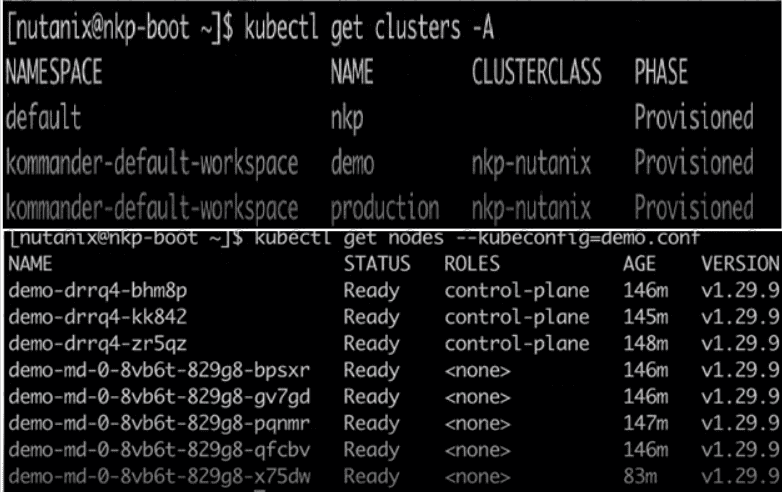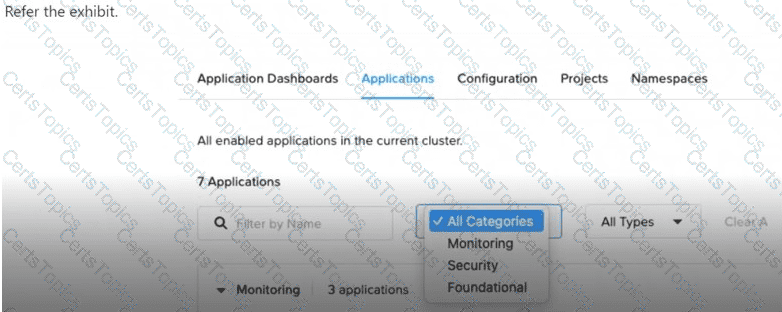To keep an NKP cluster and applications healthy and drive productivity forward, a Platform Engineer needs to stay informed of all events occurring within the cluster. What component of kube-prometheus-stack will help the engineer to stay informed of these events in NKP?
Which procedure should a Platform Engineer follow for setting up user authentication into an NKP cluster?
Recently, the reliability of some developer platforms has been impacted by out-of-memory errors, causing pods to crash and then remain in a pending state. A Cloud Engineer has been tasked with collecting and reviewing centralized metrics across the various platform environments to identify differences between them and better understand what is causing these performance issues. What should the engineer do to address this request?
When deploying NKP using the Nutanix provisioning method (CAPX), what are the supported OS platforms?
At a national defense company, protecting sensitive data is their top priority. With the increase in cyber-attacks, they have decided to implement an air-gapped Kubernetes environment to manage their critical applications, ensuring that no information could leak to the outside. The Kubernetes environment has three clusters deployed for their applications with centralized management. What type of licensing is required to enable this environment?
An administrator has experienced issues with an NKP-managed workload cluster and has been tasked with deploying NKP Insights in order to:
Resolve common anomalies
Check security issues
Verify whether workloads follow best practicesUpon trying to enable NKP Insights, the cluster that needs to be chosen is grayed out.Which missing prerequisite should be enabled?
A Platform Engineer would like to install some NKP applications, but with a few modifications to the default configuration specs of some of the components. Additionally, Velero itself can be disabled, as the company already utilizes a different backup utility for Kubernetes.
Which procedure would the engineer utilize to accomplish these goals when deploying the applications?
A Kubernetes administrator needs to deploy a new Kubernetes cluster into a new workspace. This cluster requires a predictive analytics solution that detects current and future anomalies. Which option does the administrator need to deploy after the cluster is ready?
A company has enabled auto-scaling within an NKP cluster. What is the behavior for auto-scaling?
Using an NKP Ultimate license, a Platform Engineer has created a new workspace and needs to create a new Kubernetes cluster within this workspace. However, the engineer discovers that the Create Cluster option is grayed out, as shown in the exhibit. How should the engineer resolve this issue?
Some time ago, an EKS cluster was attached to be managed with NKP (Fleet Management). Now, a Platform Engineer has been asked to disconnect the EKS cluster from NKP for licensing reasons. After disconnecting the cluster, the developers realized that application changes are still being reflected in the EKS cluster, despite the fact that the EKS cluster was successfully detached from NKP. How should the engineer resolve this issue?
A company recently deployed NKP. A Platform Engineer was asked to attach the existing Amazon EKS. A workspace and project were created accordingly, and resource requirements were met. What does the engineer need to do first to prepare the EKS clusters?
A company has 30 Edge devices with lightweight Kubernetes, and developers need to push the application to every edge device. An NKP administrator has the NKP Ultimate license tier configured and has access to all kubeconfig files for the 30 edge devices. What is the most efficient way that the administrator can lifecycle manage the application deployments?
A Kubernetes administrator needs to ensure that the following requirements are met whenever a new workload cluster is deployed to a workspace:
Grafana Logging
Grafana Loki
Project LoggingHow would the administrator ensure that these components are deployed as part of a cluster deployment?

A current Nutanix cluster is hosting an NKP cluster and a production Kubernetes cluster named production. Infrastructure administrators recently added three nodes with NVidia GPUs for a new AI initiative, and now a Platform Engineer has been asked to add three workers with the GPUs to the production Kubernetes cluster. Which first step should the engineer take to achieve this task?

The cluster arca will host a new application that needs to add more workers. The company cannot get more NKP licenses, so it has decided to delete the demo cluster and add the required workers to the arca cluster. How should the engineer delete the demo cluster from this UI?
A Platform Engineer needs to create an NKP cluster on vSphere infrastructure, using the vSphere provisioning method. The cluster needs to have 3 worker node pools:
First node pool should consist of 6 worker nodes
Second node pool should consist of 3 worker nodes
Third node pool should consist of 3 worker nodesAdditionally, the worker nodes in the first node pool should be set to 10 CPUs, the second node pool workers should be set to 8 CPUs, and the third node pool workers should be set to 6 CPUs. What is the proper way to create the NKP cluster using the NKP CLI?
A development team has decided to implement an efficient logging system and use AWS S3 as storage to manage large volumes of logs in a scalable way.
The team followed these steps:
Set the WORKSPACE_NAMESPACE variable to the namespace copied in the previous step.
Created a config that overrode ConfigMap to update the storage configuration.
Updated the grafana-loki AppDeployment to apply the configuration override.However the implementation failed.What should the team do to be able to manage log storage in AWS?
A Platform Engineer will be deploying an NKP cluster in a dark site with no Internet access. The Cloud Administrator has provided a Linux VM for this purpose, so the engineer needs to prepare this VM to be used as a bastion host. Which two actions should the engineer take to complete this task? (Choose two.)

A Platform Engineer is preparing to deploy an NKP cluster in an air-gapped environment. The NKP cluster will be deployed on Nutanix infrastructure using the CAPI Nutanix provisioner (CAPX). The engineer has decided to create the bootstrap cluster first, then NIB-prep an Ubuntu 22.04 OS image that the Linux engineering team has provided in Prism Central. After that, the engineer will deploy the NKP cluster. However, during the first step of creating a bootstrap cluster, the engineer received the error shown in the exhibit. What could be the reason?
A Platform Engineer has been tasked with building a custom image for the deployment of NKP management and worker nodes. The engineer needs to ensure that the proper package versions are used when creating these images. The security team has only authorized version 1.30.5 of Kubernetes and version 1.7.22 of containerd. Where should the engineer go to verify that this is the version being used when building the custom image?
A Platform Engineer is attaching existing Kubernetes clusters to NKP, but a particular Kubernetes Amazon EKS cluster is getting errors with application deployments. These errors are related to persistent volumes. What could be the issue, and what can the engineer do?
A Platform Engineer is a member of an IT team that provides Kubernetes clusters for three groups within a company named Fin Group, Inc.:
Fin VD
Fin Insurance
Fin TravelThe engineer created workspaces for each group. Fin Group Inc. has its own Active Directory implementation, while each group uses their own Identity Provider. Now, the engineer needs to assign the Tenant Administrators role for each workspace. How will the engineer complete this task?
Which NKP tier is required for the FIPS Compliant Build feature?
A company has decided to expand NKP to features that require higher product tiers, like fleet-management and additional infrastructure providers. The company has already obtained the necessary licensing. Which action is required when adding and activating a license from NKP Starter to a higher-tier product?
A Platform Engineer is getting started with NKP and has created a bastion host with all needed prerequisites.
How should the engineer install Kommander?
A Kubernetes administrator has been tasked with deploying a new cluster to AWS. The administrator has received the following requirements for this deployment:
Region us-east-1
AMI rhel8.6What is a requirement for deploying a new cluster in AWS?
A Platform Engineer is preparing an AWS instance using KIB for becoming an NKP cluster node. During the process, the source AMI is successfully cloned, and multiple preparation steps have occurred against the cloned AMI, such as gathering OS-release facts and uploading image bundles to it. However, the process encounters an error and ultimately fails. What is one troubleshooting step the engineer can perform that may help identify the root cause of the issue?
Refer to the exhibits.
A Cloud Administrator had provisioned a Kubernetes cluster named demo that is no longer actively being used. A Quick review from the Systems Engineer confirms that the following VMs are part of the demo Kubernetes cluster

How should the demo cluster be properly deleted?
A Platform Engineer is attempting to delete an attached cluster from the NKP UI, but it is stuck in a 'deleting' state and does not get removed. How can the engineer resolve this attempt to detach the cluster so that it is removed from the UI and no longer managed by NKP?
A Cloud Engineer is deploying an NKP cluster into an AWS environment. By default, when deploying NKP on AWS infrastructure, it generates the supporting infrastructure necessary for the cluster (VPC, subnets, ELBs). However, the AWS team has insisted that the NKP cluster be deployed on existing AWS infrastructure. How can the engineer meet this requirement?

After selecting the Production workspace and selecting View Details for the cluster prod-01, a Platform Engineer wanted to enable the NKP Insights application. This application is under the Observability category, but this category doesn’t appear in the list.
Which action should the engineer take to be able to deploy the NKP Insights application in the Kubernetes cluster for this workspace?